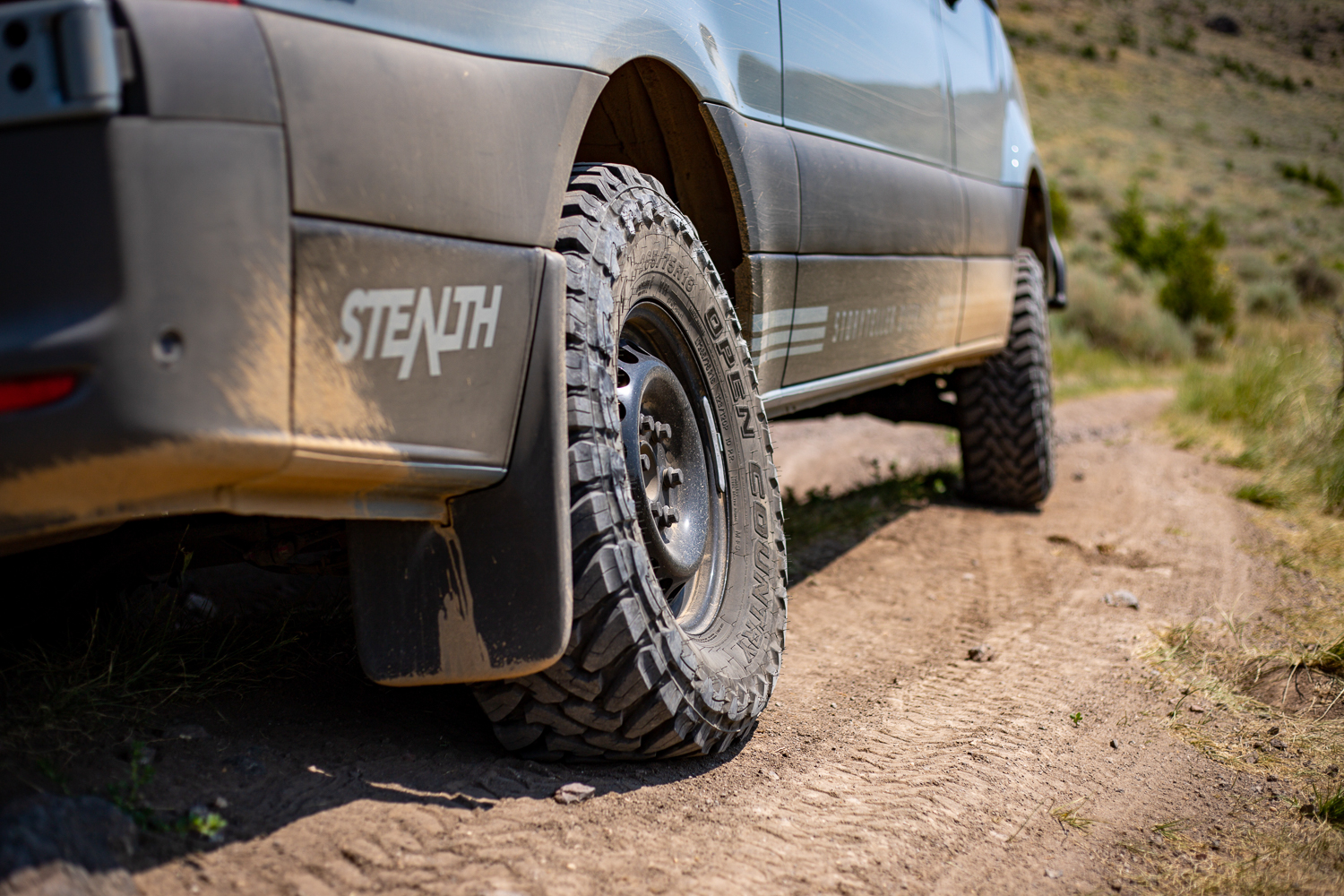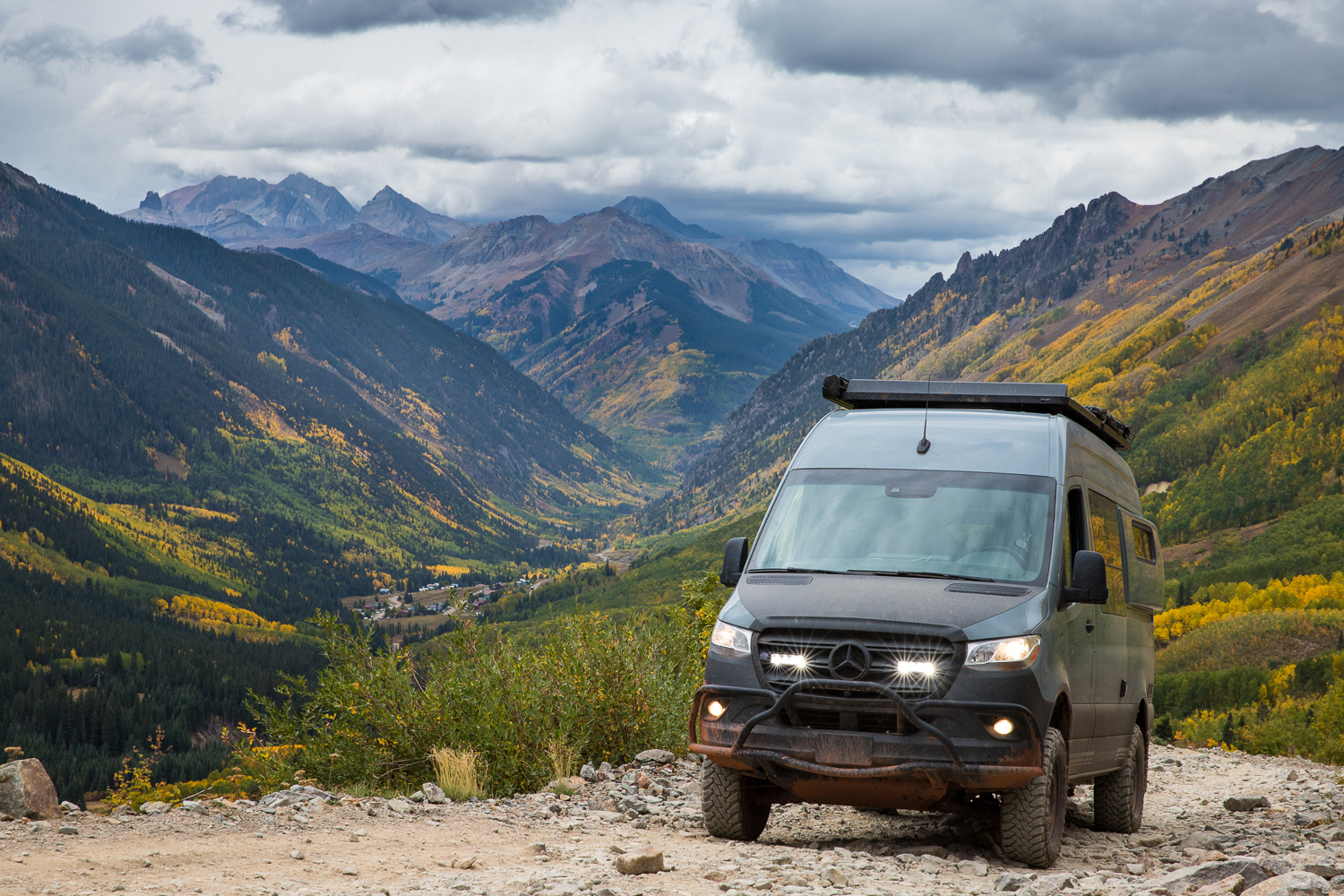There’s something undeniably alluring about mud-terrain tires. It could be their aggressive looks or reputation for trail performance, but the romantic in me says it’s something more. Like your grandfather’s ax or an old Willys Jeep, there’s an honesty to them—a rugged quality found only in purpose-built tools designed for one reason: to get stuff done. I’m a sucker for that sort of simplicity but also understand it’s rarely practical. Waxed canvas jackets leak, a chainsaw is quicker than an ax, and a mud-terrain tire just isn’t a good all-around option for a daily driver. Or is it?
Toyo Tires claims that their Open Country mud-terrain is “designed to help trucks work hard on pavement and…work just as hard when roads are muddy, snowy, and rocky.” That sounds like a suitable tire for a daily driver, which is why I threw a set onto our 4×4 Sprinter and hit the road, eager to discover how much abuse they could endure.

Testing Conditions
- Test vehicle: 2021 Storyteller Overland Sprinter
- Tire size: 265/76R16
- Load Range: E
- Starting tread depth: 18.9/32
- Tread depth: 15,000 miles, 11/32
- Weight: 61 pounds/tire
- Diameter: 31.8 inches
- Width: 10.8 inches
Disclaimer
Toyo sent me tires to test and review at no cost. We were not paid for this review, and our results are displayed honestly and without influence.
Road Performance
You don’t have to be the brightest crayon in the box to know you don’t pick a mud-terrain tire for pavement performance, but the reality is that’s where daily drivers spend most of their time. The Sprinter is no exception—long-hauls and extended adventures are its specialty, often covering thousands of miles of pavement before reaching those coveted dirt roads.
It was on these long-pavement hauls that I received my first taste of the tire’s performance in the noise, vibration, and harshness (NVH) categories. These are the most obvious characteristics (and a mud tire’s weakest points), but the Toyos felt smoother and quieter than my outgoing set of BFGoodrich All-Terrains. This isn’t unheard of in a brand-new mud-terrain, but even after 15,000 miles, which I find to be a milestone of degraded performance for most mud tires, they were quiet enough to speak conversationally with passengers. I could even take a Bluetooth call without people thinking a swarm of bees was attacking me.

Road handling was also favorable. Despite the van’s prominent height and substantial weight, the lateral stability of the Toyo’s E-rated carcass keeps the vehicle composed and predictable on the pavement. The stout construction means there is very little sidewall flex while turning, which is a huge benefit during high crosswinds and a lifesaver during emergency braking and obstacle avoidance. It inspires confidence, making 61 pounds feel like a justified trade-off rather than an outright con.
While it’s no studded tire, Toyo should be proud of this mud-terrain’s performance in winter conditions. Handling on wet and snowy roads was favorable. The relatively low void ratio (the ratio of tread blocks to the space between the blocks) provides an ample contact patch with the pavement, helping the vehicle stick on slick surfaces. This is further augmented by siping throughout the tread pattern, producing additional biting surfaces as the tire rotates and flexes to grip the road. None of this is new technology by any means but proved effective nonetheless, providing much-needed traction on the alpine roads of Montana and the mountain passes of Colorado.

On average, fuel economy dipped by 1 to 2 mpg, due to the tires’ increased weight and rolling resistance. While expected, it should be noted that 61 pounds is hefty—even for a mud tire. The rotational mass was primarily noticeable in town, where our van’s 180-horsepower motor struggles to accelerate the tires beneath 9,000 pounds of vehicle. Hey, I know it’s heavy, but it’s an apartment, not a race car.
Off-pavement Performance
If the Open Country mud-terrains are good on the road, they’re even better on the trail. They boast a wide range of design elements that enhance performance and keep us singing praises, from the rocky trails of Montana to the sand washes of the Sonoran Desert. We’ve dragged, slammed, wedged, and spun these tires on more surfaces than I can count, and while they may not look as pretty as they did 15,000 miles ago, they’re still going strong.
Their survival is more than a matter of luck. The company threw in plenty of tech to ensure their product could withstand repeated abuse on both the road and the trail. The base of their strength is a high-turn-up polyester construction, which improves the rigidity of the carcass for superior road handling and trail durability. It’s the same core structure found in many of Toyo’s commercial-grade truck tires as well as their popular A/T III. Unlike the other tires in the company’s line-up, the Open Country M/T has some additional tricks up its sleeves, including 4 millimeters of extra rubber in the shoulder lugs. This serves to protect the sidewall from punctures and bruising on the toughest trails and adds a little insurance for those “hold my beer” moments.



In all seriousness, I can’t overstate how impressed I’ve been with the durability of these tires. When you’re navigating a trail in a large vehicle like the Sprinter, picking the best line isn’t always an option. The line you take is generally the only one that fits, and whatever rocks, logs, and debris your sidewalls might drag across is just par for the course. Time and again, I’ve watched these tires wrap around a rock and manage to emerge unscathed. Toyo’s tagline “Durability in the Shape of a Tire” is no joke.
Of course, choosing a mud-terrain is about more than durability. It’s also about off-pavement traction, and the Open Country excels here, especially in mud. The unique hook-shaped tread blocks dig in easily, creating a scooping effect that improves traction while allowing the sculpted channels to clear out excess debris with each rotation. Shoulder tread provides additional oomph when things get serious, enabling you to nab more grip as you turn the tires side to side in deep mud.
These features also help the Open Country perform well in sand, which is fortunate given how much time we spend in the desert. In most sand scenarios, we air down to 20 to 25 psi, which, under a 9,000-pound van, provides enough flotation to tackle most tracks. Even when we accidentally encountered deep silt and sand along the Arizona California border at 70 psi, the Toyos kept us moving forward.


They’re no slouches in the rocks either. The softer rubber compound on the tire had no problems sticking to the slickrock in Moab or Sedona, and the rugged volcanic terrain in Montana posed no greater challenge. The larger shoulder lugs provided critical traction when side-biting surfaces were required and come in handy when you’re trying not to flop a 10-foot-tall van. However, the rocks exposed one weakness in this tire—chunking. While the Sprinter requires more throttle to negotiate an obstacle than most vehicles and tends to spin tires before the traction control kicks in, I was disappointed that the tires steadily lost small bits of the outer shoulder lugs. At this point, it hasn’t impacted the performance in any notable fashion, but as the state worsens, it likely will.

Thankfully, the tires offer plenty of other redeeming qualities: they don’t constantly pick up embedded rocks or fling them at the people behind you on gravel roads. Will some rocks get stuck in the tread? Sure, but the small ridges in the voids help eject stones as the tire flexes during rotation, preventing some of the more severe embedding that happens with other mud tires. For the most part, I’ve waved goodbye to the days of prying chunks of stone and gravel from my tires, and it feels good.
Wear and Tread Life
After such strong performance on and off the road, I felt pretty confident that the Open Country might be the tire I had been searching for. However, one critical category was left to evaluate: tread life. I drove down to our local tire shop, underwent another rotation and balance, and jotted down the new tread depth.
The results weren’t exactly what I was hoping for. After 15,000 miles, the tires dropped from an initial tread depth of 18.9/32 to 11/32. Assuming a minimum usable depth of 5/32 for a mud tire, they’ve consumed around 57 percent of their tread life, with 11,400 miles of usable tread left. In other words, their total life span is 26,400 miles.
Even if we assume a minimum safe tread depth of 2/32 (the minimum depth for passenger car tires), the total lifespan only equals 32,000 miles. That’s a little more palatable, but it certainly pales in comparison to the 60,000-mile guarantees on many all-terrain tires these days and doesn’t win the tire any points as a daily driver.

Conclusions
In many ways, the Toyos are some of the best-performing tires I’ve tested. After 15,000 miles, they ride with relatively little noise or vibration, on-road handling is impressive, performance on the dirt is fantastic, and when it comes to durability, I’d say they are second to none. Where they fall short, though, is tread life. At over $300 per tire, a total lifespan of 26,000 to 32,000 miles just doesn’t cut it for many people, especially when they can get twice that out of an all-terrain option.
That may be a deal-breaker for some, but either way, Toyo has created a remarkably well-balanced mud tire. Few, if any, of the other mud-terrains I’ve tested have aged as gracefully as the Open Country, and if you can deal with the tread life, I think you’ll be pleased with their performance. They may not last forever, but truly great things rarely do.
$315/tire | toyotires.com/product/open-country-mt/
Our No Compromise Clause: We carefully screen all contributors to ensure they are independent and impartial. We never have and never will accept advertorial, and we do not allow advertising to influence our product or destination reviews.


